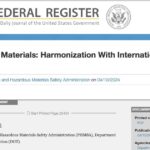You know the saying that you can’t control what you can’t measure. For hazmat teams, control is mitigating the problem once it has occurred.
And when it comes to hazardous materials moving through your jurisdiction by truck, measuring is a difficult, but necessary first step to control the threat.
That’s exactly what Ohio’s Delaware County is doing. Over the next several months, County Office of Homeland Security and Emergency Management employees will be staking out spots on four major thoroughfares and noting the number of placarded rigs passing through and what they are carrying. They are calling the effort a commodity flow study.
“It’s a study of commercial vehicles at certain points throughout the county, just a snapshot in time. It’s not all-encompassing,” the office’s director Sean Miller told the Delaware Gazette. “What this is going to do for us is start to give us a little bit of an idea as far as what is being carried through, into, or out of the county on our roadways.”
The county had 23 hazmat spills on the roadways last year and 13 so far this year.
Also Read: Three Hazmat Lessons from a Semi Chemical Spill
“This will start to paint a picture for fire departments and the hazmat team on what those realistic hazards are should an incident occur,” Miller told the Gazette. “Different chemicals pose different threats. This will help us to update our plans if necessary. It will help to drive realistic exercises in the future based on those real-world observations, and we’ll be able to generate what those top 10-20 most common chemicals are via roadways.”
The agency will also look to do a similar commodity flow study with rail lines that run through the county. For that data, they will be working with rail companies rather than relying on pure observation.
One end goal is to improve training for hazmat response teams.
“(The data will) paint a picture of … what would the potential impacts be so we can start to plan for those as well,” Miller told the paper. “We really try to have realistic trainings and exercises. The study is really just another aspect of the planning-training-exercise cycle in emergency management. Trying to plan appropriately, create trainings for first responders that are realistic and plausible, and then exercise after we’ve planned and trained. It’s a continuous cycle. (We’re) reevaluating where we’re at with our hazards in the county and pivoting as necessary based on those findings.”
Also Read: Hands-on HazMat Drills – Stop the leak
This level of data collection is beyond the scope of most hazmat teams and fire departments. Yet, having a clear picture of how much material is moving through an area would be beneficial for first responders.
Kicking off a commodity survey like this is where partnerships with different agencies come into play. With multiple agencies that would benefit from this knowledge contributing resources, it lessens the financial cost and labor burden for each agency — making the whole thing more manageable.
And once that partnership is running, it is easier to make this an ongoing project rather than a one-off.
An ongoing commodity study conducted over time will reveal trends. That can help immensely with planning how to allocate resources and when to press for more. For example, the U.S. Department of Transportation reports in its Federal Motor Carrier Safety Administration 2021 Pocket Guide that the number of hazardous materials carriers in 2016 was 98,589. That number climbed significantly each year, coming in at 120,852 by 2020.
As an aside, the number of crashes involving hazardous materials carriers has dropped from 2,500 in 2016 to 2,131 in 2020, yet the number of incidents where material was released due to a crash remained fairly constant — 553 in 2016 and 566 in 2020, reaching as high as 664 in 2018.
Not surprising, there are some technology options for gathering this type of information. For example, the Virginia Tech Transportation Institute is conducting a $280,000 study on the effectiveness of automated placard reader systems. These systems are designed to identify vehicle placards in various weather conditions, at different speeds and tie that to information such as DOT registration and license plates. The Virginia Tech study will be carried out over two locations, one controlled for speed and the other uncontrolled.
These readers, like those sold by Intelligent Imaging Systems, can link the class and type of hazmat indicated on the placard to the vehicle. The agency using the system can set the data screening rules.
It comes down to how much human capital do you want to commit versus how much financial capital. The other choice is how deep do you need the information to go. Automated readers will provide a clearer picture of the total number of vehicles. Whereas taking notes on the side of the road will offer trend data and a general idea of what is moving through the area.
Being prepared for the risk starts with understanding the scope and depth of those threats. This is one way to get at the hazmat transport issue.
Original post – Copyright © 2022 HazmatNation.com. Externally linked references may hold their own independent copyright not assumed by HazmatNation











